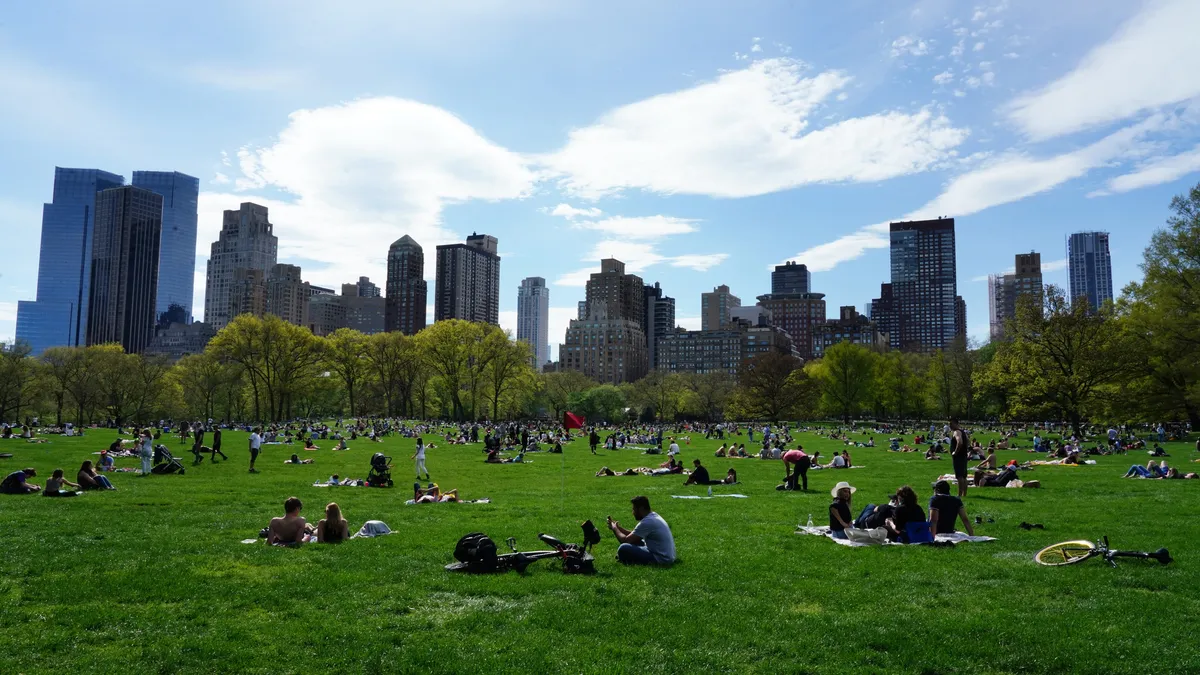Dive Brief:
- New York City’s iconic Central Park is set to get a closer look from researchers who want to assess how the important green space is being affected by climate change, and how it’s simultaneously mitigating impacts felt by city residents.
- The Central Park Climate Lab will be a joint effort by the Central Park Conservancy, the Yale School of the Environment and the New York City-based Natural Areas Conservancy. The organizers say there’s currently no unified information or policy source to help cities manage and protect parks against today's environmental challenges, and they hope takeaways on mitigation strategies will ultimately extend to urban parks across the U.S.
- The new initiative comes as the World Economic Forum has highlighted cities’ underinvestment in nature-based solutions, and that a loss of nature and biodiversity could put 44% of cities' gross domestic product at risk.
Dive Insight:
During the pandemic, Central Park has been one of the key green spaces offering crucial outdoor refuge for city residents. “Parks are essential for New Yorkers, as this last couple of years have proven, but flooding, high winds, and extreme temperatures pose a threat to their health,” newly inaugurated New York City Mayor Eric Adams said in a statement supporting the initiative.
Salmaan Khan, director of research and special projects at the Central Park Conservancy, added that the urban heat island effect, heavy rains and algal blooms have increased noticeably in recent years.
The Central Park Conservancy intends to hire someone to solely study climate change, Khan said. Ideally, the initiative will allow for a baseline assessment of metrics like temperature and water levels.
Khan said the team thinks findings or strategies stemming from that research have the potential to be scaled to parks around the country, given Central Park’s many different topographies or cover types.
"We're hyper-aware that Central Park is not a one-size-fits-all for every park around the country, but it does provide a good starting point given that it has so many different types of spaces within it," Khan said. Still, "part of our challenge here is coming up with something that is beneficial to many cities," considering that not every park is supported by a conservancy. "So how we're able to provide them with useful data, useful information, useful management practices, can be pretty critical to the success of this project."
Cities have significant room to grow in how they implement and leverage nature-based solutions, according to a World Economic Forum report out this week from the global BiodiverCities by 2030 initiative, which aims to support urban development that's in harmony with nature. The report calls out urban green spaces – including parks, greenways and green roofs – as among the important features to invest in to yield "multiple benefits for carbon storage, heat reduction, preserving biodiversity and improving wellbeing."
Akanksha Khatri, World Economic Forum’s head of nature and biodiversity, suggests it’s partially an awareness issue, writing in a related letter to mayors that in the lead-up to the report it became “clear how unfamiliar most city leaders are with the opportunities for expanding nature in the built environment.”
As that pertains to urban parklands, Khan similarly suggested that dedicated climate change research hasn’t happened sooner because cities have undervalued the role parks play. "Historically, people have viewed parks as what you would call a ‘nice to have,’ something that was not quite on par with infrastructure like roads,” Khan said. "In reality, parks are infrastructure, and as we move toward the future where climate change is more and more of an issue, they're going to be as integral in dealing with, or fighting, or working against climate change as any other bit of infrastructure."












